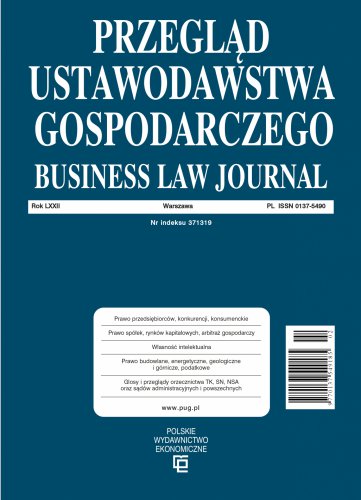Copyright challenges in the context of artificial intelligence creativity
The central problem of copyright law has been so far the lack of sufficiently precise criteria to define the limits of copyright protection. Problems with defining a work (subject of copyright) were brought to court and there was a tendency to protect items with a negligible level of originality. Technological advances, the rapid development of artificial intelligence and machine-generated creativity have brought new problems. The difficulty today is not only distinguishing copyrighted works from other objects. There are also problems with separating human from non-human creativity. Today, AI writes texts and computer programs, paints pictures, composes music. There are concerns that AI may reach levels that exceed human capabilities. The boom in AI development creates many new questions for copyright. The aim of the paper is to present the most important challenges facing copyright today. The question of attributing authorship of works created independently by creative machines comes to the fore. There is also the problem of legal liability for AI's actions. The paper presents possible approaches to the outlined problems along with the assessment of individual legal concepts.
References
Bibliografia/References
Araoz, M. (2020). Open AI's GPT-3 may be the biggest thing since bitcoin, 18.07.2020, https://maraoz.com/2020/07/18/openai-gpt3/ (pobrano 27.11.2020).
Komisja Europejska (2020). Biała księga w sprawie sztucznej inteligencji. Europejskie podejście do doskonałości i zaufania. 19.02.2020, COM (2020) 65 final.
Bonadio, E., L. Mcdonagh, L., & Arvidsson, C. (2018). Intellectual property aspects of robotics. European Journal of Risk Regulation, 9(4), 655–676. https://doi.org/10.1017/err.2018.58
Bussler, F. (2020). Will GPT-3 Kill Coding? AI can now code in any language without additional training. 21.07.2020, https://towardsdatascience.com/will-gpt-3-kill-coding-630e4518c04d (pobrano 12.30.2020).
de Cock Buning, M. (2016). Autonomous intelligent systems as creative agents under the EU framework for intellectual property. European Journal of Risk Regulation, 7(2), 310–322. https://doi.org/10.1017/S1867299X00005730
Flisak, D. (2018). Komentarz do wybranych przepisów ustawy o prawie autorskim i prawach pokrewnych. LEX/el.
Gawlik, B. (Red.). (1999). Dobra osobiste. Zbiór orzeczeń Sądu Apelacyjnego w Krakowie. Kantor Wydawniczy Zakamycze.
Guadamuz, A. (2016). The monkey selfie: copyright lessons for originality in photographs and internet jurisdiction. Internet Policy Review, 5(1).
Ginsburg, J. C. (2018). People not machines: Authorship and what it means in the Berne Convention. International Review of Intellectual Property and Competition Law, 49, 131–135. https://doi.org/10.1007/S40319-018-0670-X
Jankowska, M. (2011). Autor i prawo do autorstwa. Wolters Kluwer.
Jankowska, M. (2013). On the implications of the inalienability of the right of authorship for ghostwriting contracts. Review of Comparative Law, 18, 77–92.
Jasińska, K. (2009). Glosa do wyroku SN z 27.2.2009 r. LEX/el.
Juściński, P. P. (2019). Prawo autorskie w obliczu rozwoju sztucznej inteligencji. Zeszyty Naukowe Uniwersytetu Jagiellońskiego, Prace z Prawa Własności Intelektualnej, 1(143), 5–44.
Komisja Europejska (2021). Komunikat Komisji do Parlamentu Europejskiego, Rady, Europejskiego Komitetu Ekonomiczno-Społecznego i Komitetu Regionów: Promowanie europejskiego podejścia do sztucznej inteligencji COM/2021/205 final.
Księżak, P., & Wojtczak, S. (2021). Prawo autorskie wobec sztucznej inteligencji (próba alternatywnego spojrzenia). Państwo i Prawo, (2), 18–33.
Kotzé, J. L., & French, D. (2018). The anthropocentric ontology of international environmental law and the sustainable development goals: Towards an ecocentric rule of law in the anthropocene. Global Journal of Comparative Law, 7(1), 5–36. http://doi.org/10.1163/2211906X-00701002
Machała, W. (2021). Utwór. Przedmiot prawa autorskiego. C.H.Beck.
Maggiore, M. (2018). W: E. Bonadio, N. Lucchi (Red.), Non-conventional copyright — Do new and atypical works deserve protection?, Edward Elgar Publishing.
Markiewicz, M. (2021). W: R. Markiewicz (Red.), Ustawy autorskie. Komentarze. Tom I. Wolters Kluwer.
Nowak-Gruca, A. (2018). Przedmiot prawa autorskiego (utwór) w ujęciu kognitywnym. Difin.
Oleksiuk, I. (2003). Twórczość u progu sztucznej inteligencji. Zagadnienia autorskoprawne. Studia Medioznawcze, 3(13), 93–103.
Oleksiuk, I. (2017). Założenia aksjologiczne autorskoprawnej ochrony twórczości w świetle rozwoju sztucznej inteligencji. Acta Iuris Stetinensis, 2(18), 245–262.
Palace, V. M. (2019). What if artificial intelligence wrote this? Florida Law Review, 71(1), 217–242.
Parlament Europejski (2017). Rezolucja Parlamentu Europejskiego z 16.02.2017 r. zawierająca zalecenia dla Komisji w sprawie przepisów prawa cywilnego dotyczących robotyki (2015/2103 (INL)).
Ritterman, S. (1959). Glosa do orzeczenia SN z 12.03.1958 r, II CR 347/57. Orzecznictwo Sądów Polskich, (5), poz. 125.
Salah, A. A. A., & Salah, A. A. (2008). Technoscience art: A bridge between neuroesthetics and art history? Review of General Psychology, 12(2), 6–20.
Sarbiński, R. M. (2019). W: W. Machała, R. M. Sarbiński (Red.), Prawo autorskie i prawa pokrewne. Komentarz. Wolters Kluwer.
Sarbiński, R. M. (2018). Komentarz do art. 1 ustawy o prawie autorskim i prawach pokrewnych. Lex Omega.
Schwab, K. (2018). Czwarta rewolucja przemysłowa. Studio Emka.
Shlomit, Y. R. (2017). Generating Rembrandt: Artificial intelligence, copyright, and accountability in the 3A era — The human-like authors are already here — A new model. Michigan State Law Review, 659, 659–725.
Szaciński, M. (1993). Wkład twórczy jako przesłanka dzieła chronionego prawem autorskim. Państwo i Prawo, (2), 50–56.
Traple, E. (2015). W: E. Traple (Red.), Ochrona gry komputerowej. Aktualne wyzwania prawne. Wolters Kluwer.
Traple, E., & Trafas, T. (1984). Korzystanie z dokumentów pierwotnych w działalności dokumentacyjnej i informacyjnej (analiza i oceny na gruncie prawa autorskiego). Zeszyty Naukowe Uniwersytetu Jagiellońskiego, Prace z Wynalazczości i Ochrony Własności Intelektualnej, (35), 21–25.

